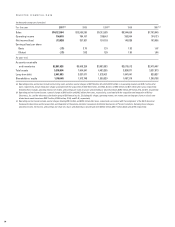Arrow Electronics 2001 Annual Report Download - page 20
Download and view the complete annual report
Please find page 20 of the 2001 Arrow Electronics annual report below. You can navigate through the pages in the report by either clicking on the pages listed below, or by using the keyword search tool below to find specific information within the annual report.
20
NOTES TO CONSOLIDATED FINANCIAL STATEMENTS
1 Summary of Significant Accounting Policies
Principles of Consolidation
The consolidated financial statements include the accounts of
the company and its majority-owned subsidiaries. All significant
intercompany transactions are eliminated.
Use of Estimates
The preparation of financial statements in conformity with generally
accepted accounting principles requires management to make
estimates and assumptions that affect the amounts reported in
the consolidated financial statements and accompanying notes.
Actual results could differ from those estimates.
Cash and Short-term Investments
Short-term investments which have a maturity of ninety days or
less at time of purchase are considered cash equivalents in the
consolidated statement of cash flows. The carrying amount reported
in the consolidated balance sheet for short-term investments
approximates fair value.
Financial Instruments
The company uses various financial instruments, including derivative
financial instruments, for purposes other than trading. The company
does not use derivative financial instruments for speculative purposes.
Derivatives used as part of the company’s risk management
strategy are designated at inception as hedges and measured
for effectiveness both at inception and on an ongoing basis.
Inventories
Inventories are stated at the lower of cost or market. Cost is
determined on the first-in, first-out (FIFO) method.
Property, Plant and Equipment
Property, plant and equipment are stated at cost. Depreciation
is computed on the straight-line method for financial reporting
purposes and on accelerated methods for tax reporting purposes.
Leasehold improvements are amortized over the shorter of the
term of the related lease or the life of the improvement. Long-lived
assets are reviewed for impairment whenever changes in circum-
stances or events may indicate that the carrying amounts may not
be recoverable. If the fair value is less than the carrying amount
of the asset, a loss is recognized for the difference.
Cost in Excess of Net Assets of Companies Acquired
The cost in excess of net assets of companies acquired is being
amortized on a straight-line basis over periods of 20 to 40 years.
Management reassesses the carrying value and remaining life
of the excess cost over fair value of net assets of companies
acquired on an ongoing basis. Whenever events indicate that the
carrying values are impaired, the excess cost over fair value of
those assets is adjusted appropriately.
Foreign Currency Translation
The assets and liabilities of foreign operations are translated at
the exchange rates in effect at the balance sheet date, with the
related translation gains or losses reported as a separate compo-
nent of shareholders’ equity. The results of foreign operations are
translated at the monthly average exchange rates.
Income Taxes
Income taxes are accounted for under the liability method.
Deferred taxes reflect the tax consequences on future years of
differences between the tax bases of assets and liabilities and
their financial reporting amounts.
Earnings (Loss) Per Share
Basic earnings (loss) per share is computed by dividing income
(loss) available to common shareholders by the weighted average
number of common shares outstanding for the period. Diluted
earnings per share reflects the potential dilution that would occur if
securities or other contracts to issue common stock were exercised
or converted into common stock.
Comprehensive Income (Loss)
Comprehensive income (loss) is defined as the aggregate change
in shareholders’ equity excluding changes in ownership interests.
The foreign currency translation adjustments included in compre-
hensive income (loss) have not been tax effected as investments
in foreign affiliates are deemed to be permanent.
Segment Reporting
Operating segments are defined as components of an enterprise
for which separate financial information is available that is
evaluated regularly by the chief operating decision makers in
deciding how to allocate resources and in assessing performance.
The company’s operations are classified into two reportable
business segments, the distribution of electronic components
and the distribution of computer products.
Revenue Recognition
The company recognizes revenue in accordance with SEC Staff
Accounting Bulletin No. 101, “Revenue Recognition in Financial
Statements” (“SAB 101”). Under SAB 101 revenue is recognized
when the title and risk of loss have passed to the customer, there
is persuasive evidence of an arrangement, delivery has occurred
or services have been rendered, the sales price is determinable,
and collectibility is reasonably assured. Revenue typically is
recognized at time of shipment. Sales are recorded net of discounts,
rebates, and returns.
Software Development Costs
The company capitalizes certain costs incurred in connection
with developing or obtaining software for internal use. Capitalized
software costs are amortized on a straight-line basis over the esti-
mated useful life of the software, which is generally three years.
























